A group of us were walking down Empire Street in Downcity around 8:30pm on a Saturday night, and we saw a van, admittedly parked in a no-parking zone, right outside AS220. Our attention was captured by two items: one a hand-lettered cardboard sign on the dashboard explaining that the owner of the van was homeless and asking not to be ticketed, and a bright orange Providence parking ticket under the windshield wiper. The incongruity motivated Motif publisher Mike Ryan to take a photo, expressing the opinion that it had been “a dick move” to issue that ticket.
Around 11:30pm, I was walking back alone in the other direction and saw the side doors of the van open with a young man sitting amidst an array of art on the sidewalk he was hoping to sell, mostly silk-screened canvases. That was dedication: The temperature was in the mid-30s and headed lower, and it was nearly midnight. I was wearing an insulated hat and gloves, but he had a simple knit cap and no gloves.
I asked about the parking ticket. “Yeah,” he said with an air of resignation but hardly defeat, “Now I gotta pay that, too.” How often does he get parking tickets? “It happens.”

He told me his name is Patrick Oliveira. He is 20 years old and has been making art since he was in middle school, half his life so far. His Instagram account with over 4,700 followers has a name that, while iconoclastically uncommercial, seemed in perfect ironic synchrony with that parking ticket: @fuckpat.
As we were talking, a woman excitedly ran up, introduced herself as Michelle, and said that her husband had told her she had to go see the man with the red mohawk. Confusion momentarily ensued as neither Pat nor I sport a mohawk, red or any other color, and as noted both of us were wearing hats. It turned out the “man with the red mohawk” was for sale, made from a photo Pat had taken and then enhanced onto canvas. Michelle fell in love with it and asked the price.
Pat, I could see, was struggling with the terrible agony that has afflicted artists since at least Michelangelo: ask too little and the work is undervalued, but ask too much and they’ll just leave the ceiling blank. It was also his first sale of the day, he later told me, after many hours earlier on Thayer Street. He asked for $80.
Michelle agreed, subject to a condition: she wanted to hang it in her dining room but Pat had to sign the canvas so that it would be more valuable “when you become famous like Shepard Fairey.” He apologized because he had nothing with which to sign it. Neither did she.
“I can solve that problem,” I said, pulling a black Sharpie clone from my pocket and handing it to Pat. He duly signed the canvas, and the sale was completed.
That was, indeed, how Shepard Fairey got his start, selling individual pieces, such as T-shirts silk-screened by hand, a few feet away from that exact spot.
I don’t think Pat bought into any expectation that he would “become famous like Shepard Fairey,” but he signed the canvas anyway. Art is art if it speaks to people, and The Man with the Red Mohawk was good, captivatingly good in a way that embodies life in Providence as much as that parking ticket.
I told Pat to keep the Sharpie clone in case he was asked to sign anything else.


